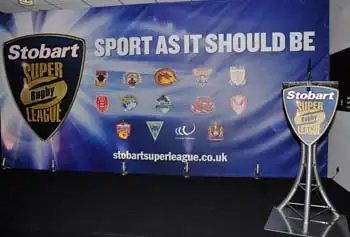Time for a 10 team Super League

The last time Castleford played Widnes it was a game of meaning with lots at stake – Monday’s Super League clash between the two was anything but.
That last meeting was the 2007 National League 1 Grand Final, in which the Tigers triumphed 42-10 at Headingley to earn their promotion to Super League, while Widnes collapsed in to administration literally the day after.
The Vikings are in much better hands now thanks to the subsequent takeover by Steve O’Connor, but they have found their own step up in to Super League extremely tough, losing 11 of their 13 fixtures so far, and conceding 30 points or more in all of them.
That is despite having since March 31st last year to recruit a squad capable of competing, the extra time that was supposedly meant to enable them to be more competitive than if a team was promoted via the Championship Grand Final in October, as when promotion and relegation was in force.
It is perhaps a reflection of the Vikings’ dismal away form that their 36-12 defeat at the PROBIZ Coliseum in front of the SKY Sports cameras on Monday was probably their best away display of the season.
They were well in the game at 10-8 down, but suffered an alarming collapse as Rangi Chase-less Cas ran away with it.
But the game was a turn-off. No intensity, no bite and no meaning. All a regular feature of the 14-team closed shop that is Super League today.
The last Super League meeting between the two saw Castleford edge the Vikings 7-6 at the Halton Stadium in the penultimate round of 2004, a scrappy game played in the driving rain, but one full of drama as both clubs fought relegation.
As it turned out, the win wasn’t enough to save Castleford, who went down courtesy of Wakefield the following week, but a game of such meaning has never quite felt as far away as it did on Monday.
Realistically, these lower league clashes are merely a break from getting battered by the top clubs, and while there were no relatively lopsided score-lines in this round of Super League, neither Wakefield or Hull KR got close to victory in their defeats at St Helens and Wigan.
The danger is that while the clubs at the top grow, they’re getting held back by the clubs at the bottom. The likes of Wigan, Leeds and Hull can all be (and to an extent are) big sporting powerhouses in the UK, and they are professional organisations that could stand up alongside many a football club.
While the worry in previous years has been about the growth of the gap between Super League and the Championship, there now has to be some attention to the gap that is being created between the top Super League clubs and the rest.
Two 10 team Super League’s, an idea championed by our very own Gavin Wilson and Forty-20 Magazine’s Twitter extraordinaire Tony Hannan, with promotion and relegation in between would mean a competitive fixture card each week, as well as add meaning to games like Castleford and Widnes.
If clubs like the Vikings want to show ambition and compete with the big boys, they will have the chance to earn their place in the first Super League division, and likewise, the big boys in the top 10 cannot afford complacency as it could see them drop out of the top flight.
How it might look:
Super League 1: Bradford, Catalan, Huddersfield, Hull, Hull KR, Leeds, Salford, St Helens, Warrington, Wigan
Super League 2: Castleford, Featherstone, Halifax, Leigh, London, Sheffield, Wakefield, Widnes + Welsh club + French club
Before anyone shouts at me for the selections, the two up two down promotion and relegation structure would soon change things, and allow the likes of London to compete at the top of Super League, if they were able to get the structure in place to do so.
There aren’t any more than six clubs outside of Super League that harbour realistic top flight ambitions, and as such, a move to 20 clubs would help to appease many of those frustrated by the Championship’s glass ceiling.
Promotion, based on a number of set criteria, between Super League 2 and the Championship could exist, ensuring that there was a pathway to the top flight, and encouraging the pyramid feel that football has implemented with great effect. With the re-structure of the community game, there has never been a more opportune time to implement an up-down pyramid structure throughout the sport.
The key to it all is implementing the appropriate revenue share between the two leagues. The second division would have a lower salary cap, enabling the clubs to focus more of their spend on commercial growth and marketing.
The reduction in fixtures would require an additional competition to be founded – say the Super League Cup – which would put the 20 teams in to five groups of four. If you picked two teams from each league for each group, it would then give the likes of Widnes and Castleford the chance to still play (and enjoy the financial benefits) of big games against Warrington and Leeds respectively, for instance (heck, if it was done fairly, these cross-over fixtures could be implemented in to the league tables)
A few weekends per season would then be freed up, potentially for more international matches or to accommodate a revamped World Club Challenge – imagine if the battle for the top four in Super League 1 was akin to the chase for the Champions League places in football’s Premier League.
A thriving, competitive domestic league with powerhouses such as Wigan and Warrington could be key to making Super League a league that other sports envy.
It’s an idea open to ridicule and change but the fact remains – Super League cannot go on for much longer in its current form.